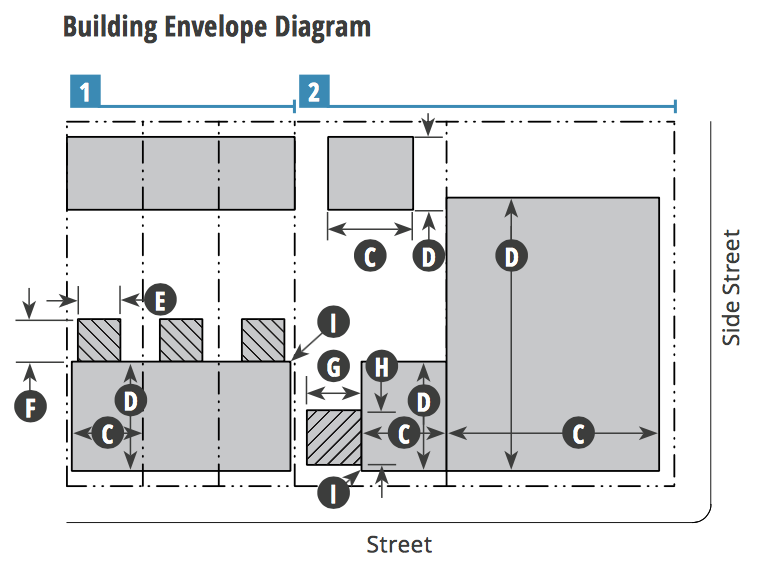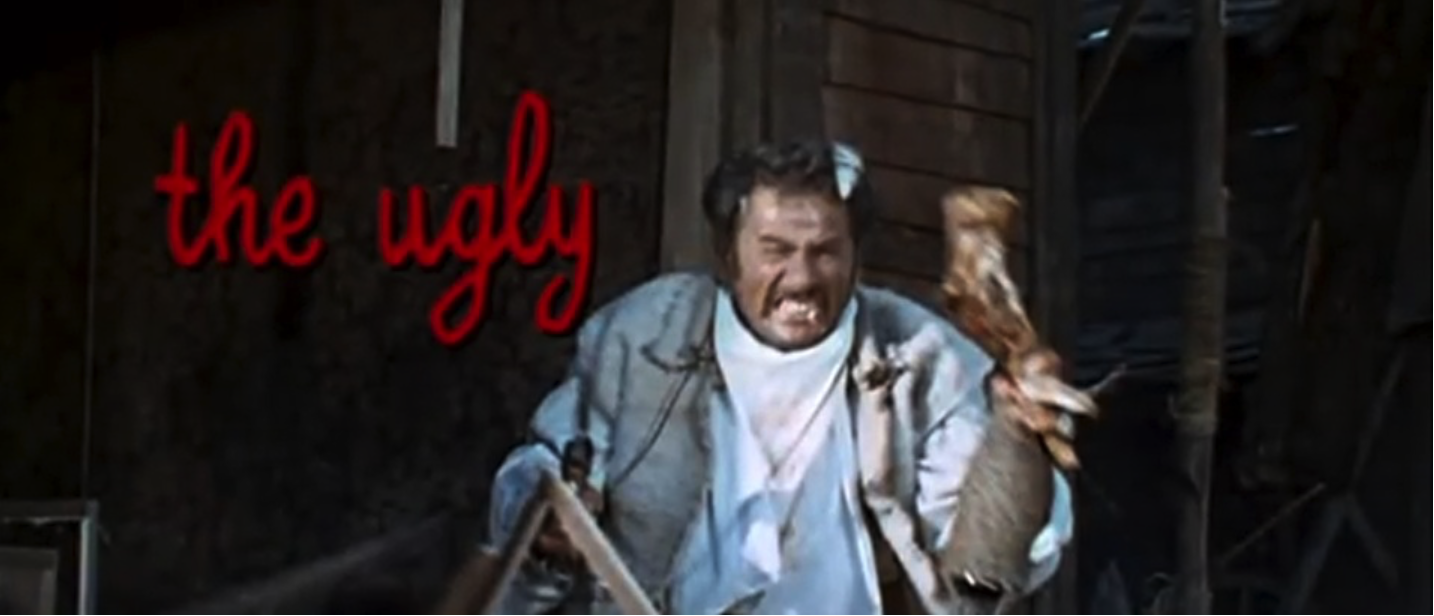Fourth in a series by friend-of-the-blog Mateo Barnstone. This post focuses on the bad and ugly sides of CodeNEXT and how it could do better. For what’s good and why, see the previous post.

The Building Envelope
As they say, the devil is in the details – and oh boy are there a lot of details. Each Transect contains 8 pages and 16 subsections of details. There are 3 transects that are sliced into 13 sub-transects (not including the Open variations). Form is tightly constrained by belts and suspenders, and just to be sure, more belts. Sometimes the variations between districts are great, other times oddly narrow. For example, the building envelope for the Medium Rowhouse in the T4MS/O district is allowed to be 48’ deep but in the T5N.SS district the Medium Rowhomes is limited to 45’. The same is true for the Large Rowhomes. Why the need for this variation is unclear.
Keep in mind that the transects only describe what is theoretically possible under ideal circumstances. Geographic constraints, heritage trees, environmental features, open space, stormwater management requirements and other constraints will surely curtail the actual ability to build of units – predicting exactly how these competing regulations will impact the ability to deliver product will be very challenging.
Part of the problem lies with the fact the form that is overly prescriptive. A row house shouldn’t be particularly complicated to code for. It’s four exterior walls, a roof, and adornments appropriate to the style. A building envelope for a row house should be simple – pick the height and the front and rear set backs you want and allow for appropriate encroachments. Instead, we get this:

Rather than describe a simple box, this code includes side wings and rear wings, one might suppose in an attempt to introduce McMansion style articulations, something that makes little sense in the context of a row home. Inside lots lines should always be zero and it’s unclear who benefits from a rear articulation, outside lot lines would impact the continuous perimeter that is characteristic of row home lined streets and there’s no reason to care about a rear articulation 50’ deep into a lot. It’s unnecessarily complicate and should not be carried forward in the next draft.
Relation to the Street
More importantly, this distinction between alley and non-alley access reveals a secondary problem. Row homes should not front streets when you can’t provide rear access or limit front access via a shared drive. Narrow lots and front access driveways are a bad combination because they degrade the public realm. Placing the garages up front on row homes means your sidewalk is a nearly continuous curb cut, it makes on street parking difficult, if not impossible, and creates an unpleasant face to the street dominated by garage doors.

I suggest they simply not allow row homes except when rear access can be provided either by alley or through a shared drive to a rear shared drive that acts like an alley. Absent an alley only one shared driveway per run of units should be allowed with access to a shared drive in the rear. Streets fronted by Rowhomes on alleys would have no curb cuts and streets without alleys could have only 1 curb cut per 100’ of frontage.
At the same time, they should eliminate the distinction the 100’/75’ distinction between being on an alley or not – a shared drive in the rear is essential a private alley – there’s no good reason to distinguish between shared drives and alleys.
Ideally, CodeNEXT should eliminate the depth dimension on the lot and simply let the minimum lot size control for density and form. However, short of that, there’s no reason we should have a lot depth larger than the units being provided for at Mueller and suggest if a lot depth is required it should be at 75’ for all Rowhomes.
Another form regulation is that the code mandates 14’ floor-to-ceiling heights on the ground floor and 9’ on the upper floors. This is expensive to build and inefficient to heat and cool as well. Why are they requiring this?
In all likelihood, it’s because the transects that these row homes are permitted, T4MS and the T5 transects, are mixed use and fairly intense districts. The intent of the 14’ minimum height on ground floors is likely to allow for or preserve the possibility for commercial future uses.
This does make sense in those transects, but also calls attention to the fact that this is not really meant to be an affordable single family attached housing product in either the Medium or Large flavors. The Large and Medium Rowhomes, as proposed, may well produce engaging and active human scaled streets and potentially contributed to mixed districts – but they’re very unlikely to produce anything but very nice and very expensive homes.
Parking Limitations
The draft makes progress with regards to parking by halving the number of spaces required by residential units. This is an important advancement and should be defended against inevitable attacks. That being said, with all the talk about the promise of autonomous cars and Austin’s embracing this as a driving force for the future, it’s curious that they didn’t take the bold step that Buffalo has just done by eliminating parking minimums – at least in the more intense transects that the Rowhomes are limited to.
While the code makes theoretical 3 units + an ADU per building in runs of 3, 4 or up to 12, as practical matter, there’s only so much parking that fits on a narrow lot. The typical Mueller rowhouses lots are 22.5’ wide and can just accommodate 2 cars parking side by side.
Even if the market supports 1 parking space per unit, it would be impossible to provide 3 or 4 parking spaces on a narrow lot. So while parking is a bright spot in the code, it still serves as an effective limitation on units. Unless they allow a street space to count towards the parking minimums, at most, I would expect one or two units per building, not the 3-4 theoretically allowed.
Run of Homes
As we noted above, Rowhomes are required to be constructed in runs that are limited by both buildings and length (more belts, more suspenders). However, in some cases, the run of buildings doesn’t seem responsive to Austin’s lots. SF3 (the most widely zoned district) has 50’ lot width minimums and because much of early Austin was platted with 25’ x 125’ lots that were combined to 50’ lots we have many 50’ lots.

In terms of prescribing a run of buildings it makes sense to think of how many Row Homes could be built by someone who’s assembled two standard lots. In Austin that would typically be a minimum of 100’ frontage which could accommodate as many as five 18’ row homes (if on an alley) or as few as three 28’ row homes.
The T4MS zone prescribes a run of 3-4 buildings with a maximum combined width of 75’. This seems like an arbitrary cap in terms of both buildings and width. Having limits on scale and massing is fine but in determining what that limit should be it would also make sense to imagine what might be possible by someone who’s assembled two standard lots – about 100′ on which between 3 and 5 row homes could be comfortably built.
A final note about the run of buildings. Having a minimum and maximum makes sense to me in the neighborhood context. If you allowed single row homes, you would get more organic development, but embedding that into fully built out neighborhoods is tricky and you’d get individual buildings with flat sides, no windows on a zero lot line and would stick out like a sore thumb. Building them in runs of three or more makes contextual sense and I believe this will be more acceptable to residents in existing neighborhoods.
I’m not sure that holds in the T4MS transect which is really a neighborhood commercial street. There, it would make sense to allow the more organic development and allow individual row houses to build to the lot lines and not prescribe runs.

Medium and Large Flavor Rowhomes are an exciting addition to the range of options we have in Austin. With a few tweaks to the regulations and the right mapping this could result in transformative change for small sections of the city. However, the draft code limits the use of Rowhomes to the most intense T4 subzone and T5 transect. We don’t have a map yet, no one knows exactly what to expect, but if reports are to be believed, we’ll only see about 20% of the city mapped initially with the transects.
We’ve also been told most neighborhoods will not change significantly. The fact is that all the transects where Rowhomes are allowed in the draft code would be very significant changes to Austin single family neighborhoods. While we might get a smattering of them throughout the city, the chances of a wide-spread application in residential neighborhoods of these intense transects seems exceedingly remote given current messaging.
The Rowhomes are entitled to have multiple units on them, and exist in transects with other buildings as intense or moreso. As such we’re very unlikely to see any iterations as single family, attached, fee-simple home. Certainly if we do get these, it would only be in the form of very expensive mansions.
Still missing from the Missing Middle is a Small Flavor of Row Home: a 2 or 2 ½ story single family attached unit that a family can owned in fee-simple (i.e. not as part of a condo regime).
The absence of this option is conspicuous. It is one of the most common housing products in Mueller and it’s proven to be in high demand there and in the Crestview TOD. Why is this true missing middle option for the middle classes off the table? Why aren’t row houses permitted in the other transects with missing middle housing types such as cottage courts and multiplexes?
The likely reason is political opposition. It was alluded in a recent presentation on the code that the intensity of use that Row Homes permit would mean widespread adoption and rapid transformation of established neighborhoods. Perhaps a calculation was made that introducing row homes the mix would kill acceptance of those transects and preclude some of the other missing middle housing types from much of Austin.
Whatever the reason, this is something that needs to change in the next draft or we will not see fee-simple attached housing as a real option in this city. In my list of suggested changes below I’ve included adding a small flavor rowhouse that can be built as single units + ADU in runs of 3 – 5. There is no reason why this form of housing can’t co-exist in neighborhoods that also allow multi-plex homes (T4N.IS and T4N.SS) and even cottage court homes (T3N.DS and T3N.IS).
While row homes will not solve all our affordability issues, the value of land and construction costs are such that it will be very difficult for any builder to deliver new housing that is deeply affordable, it can be attainable housing in a way that the single-family detached home has ceased to be. Austin is a desirable city, blessed to be in a beautiful part of the country with a robust economy and a creative spirit that attracts many. We’re going to a need a lot of housing options if we’re going to avoid the path of San Francisco – a very lovely place for the very wealthy.
I’m glad to see Rowhomes featured as part of this mix because they potentially combine affordability that people need with the privacy and control of their homestead that people crave. This draft code doesn’t quite get us there and as provided for we’re unlikely to see these make a significant dent into the overall housing market. However, this is just a draft and the things that make it difficult are quite fixable. If row homes are something the community desires as a widely available as an option and lets the consultant and staff know, the code can be revised to make them a reasonable option.
TL;DR
The Good: The form, scale and massing of the Medium and Large flavor Rowhomes, the theoretical ability to do house up to 4 families on a narrow lot, and flexibility of use is an exciting addition to the landscape of available options.
The Bad: The building envelope is overly prescriptive and should be relaxed. 14’ ground floors will ensure this is an expensive housing type. Minimum parking requirements remains a real limitation on theoretical units in a building.
The Ugly: Where these can be built is at once too liberal and too restrictive. Front access does not work for narrow lot homes and should be prohibited except where a shared drive can provide rear access. However, because the transects are limited to the most intensive residential districts, we’re unlikely to see much of these in the city. There must be a Small flavor added in other T4 and T3 districts to achieve the promise of this missing middle housing type.
The Comments Section
Staff and consultant are asking the public to comment directly onto an on-line version of the draft code. If you want to provide feedback to the consultant about things they are doing right and things that need attention, it’s highly recommended that you do so. You can register to make comments (and see everyone else’s) directly into the code by going here and registering at the Add Comment box.
Below are a few of the comments and suggestions that I will be making.
| Comment | Page |
| Options | |
Add a Small Rowhouse flavor for the T4N.IS and T4N.SS as well as T3N.DS and T3N.IS transects.
|
23-4D-2100 / pg 32
23-4D-2110 / pg 40 23-4D-2120 / pg 48 23-4D-2130 / pg 56 |
| Permit a Small Rowhouse flavor in T4MS in addition to Medium flavor | 23-4D-2140 / pg 64 |
| Allow a 5 story option of the Large Rowhouse on the T5U and T5MS. | 23-4D-2140 / pg 64 |
| Allow for a cottage court row home variety for large/deep lots. | 23-45-2060 / pg 13 |
| Mapping | |
| Map row home zones into urban neighborhoods and transitional neighborhoods planned for more walkability where you want transit supportive density in a residential context. Limit to lots with rear access (via alley or shared front or side drive). Permit up to one curb cut per 100′ frontage of row house units. | |
| Relax the Building Envelope | |
| Eliminate Depth Requirement – setbacks and lot width are sufficient to control form. If must limit density, do so with lot size. If depth measurement required, select the 75’ on all units on alleys or with rear shared drive. | Subsections C in sections:
23-4D-2140 / pg 63 23-4D-2150 / pg 71 23-4D-2160 / pg 79 23-4D-2170 / pg 87 |
Eliminate side building and rear wing articulations.
|
23-4D-2140 / pg 64
23-4D-2150 / pg 72 23-4D-2160 / pg 80 23-4D-2170 / pg 88 |
| Parking | |
| Credit 1 on-street parking space per building towards parking minimums. | 23-4D-2140 / pg 67
23-4D-2150 / pg 75 23-4D-2160 / pg 83 23-4D-2170 / pg 91 |
| Consider eliminating all parking minimums on the Main Street transects. | 23-4D-2140 / pg 67 |
| Building Runs | |
Eliminate Length of Runs – just limit the units in a row to control massing.
|
23-4D-2140 / pg 64
23-4D-2150 / pg 72 23-4D-2160 / pg 80 23-4D-2170 / pg 88 |

One thought on “Get Your Housing in a Row: Changes to make CodeNEXT Row House compatible”
Comments are closed.